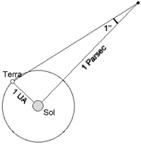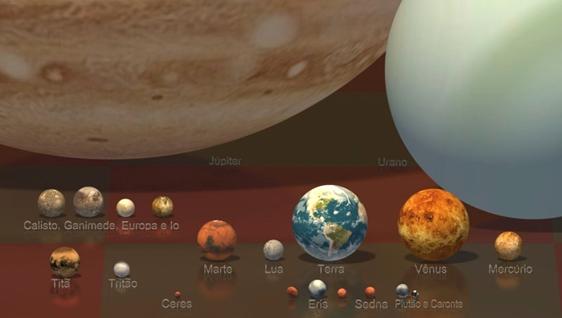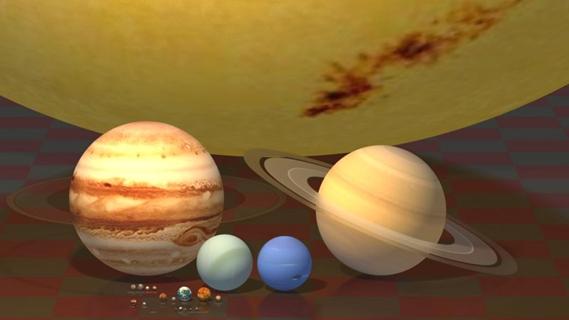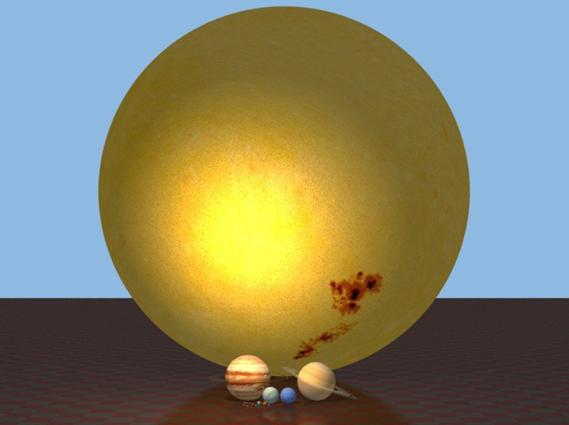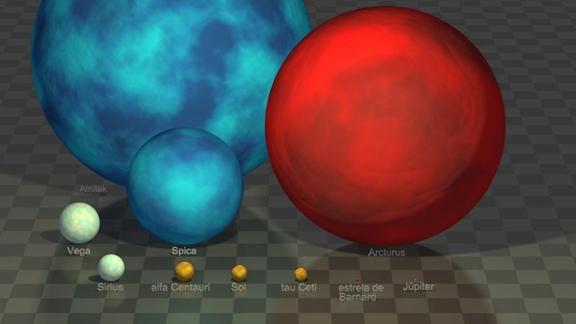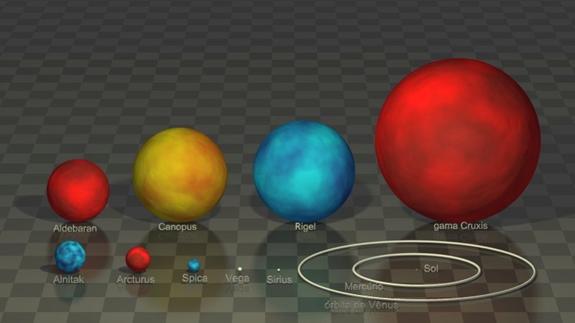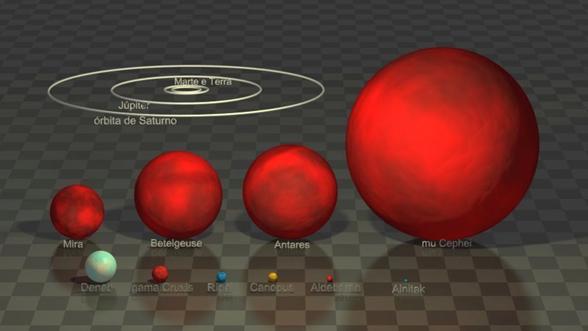 |
||||||||||||||||||||||||||||||||||||||||||||||||
HomeSolar system UniverseAstronomy historyAstronomical distances and sizes |
||||||||||||||||||||||||||||||||||||||||||||||||
Astronomical distances and sizes |
||||||||||||||||||||||||||||||||||||||||||||||||
|
Why a section exclusively for astronomical distances and sizes?
It is because we need to have an exact idea of our importance. We are only a tiny tip in comparison with the greatest stars, but we have the miracle of life, apparently absent in other parts of the universe.
There are three main units used to measure astronomical distances: - astronomical unit (AU or UA) - light-year (la) - parsec (pc)
The astronomical unit is based on the average distance between the Sun and the Earth, defined as one astronomical unit. It is equal 149 597 870 km @ 1,5.108 km (150 million km = 500 light-seconds @ 8.3 light-minutes).
Astronomical unit - size of the astronomical objects out of scale. Available at: http://www.astro.iag.usp.br/~ronaldo/intrcosm/Glossario/UA.html
The light-year is the distance traveled by light in a year. We can get this value in kilometers, multiplying the speed of light in vacuum (@ 2,99.105 km/s quase 300 mil km/s) by the time of a year in seconds (@ 3,15.107s = mais de 31,5 milhões de segundos). One light-year is approximately 9,46.1012 km @ 9,5. 1012 km (9,5 trillion of kilometers).
It is the most used unit in scientific work in astronomy. This is a more complex unit, related to the concept of parallax. By definition, is the distance between a point in space from Earth. A point where the angle between the segments that join it to Earth and to Sun is 1 second of arc (see figure below). It is equivalent to approximately 3,1.1013 km (31 trillion of kilometers) @ 3,26 light-year @ 206265 UA.
Parsec. Disponível em: http://www.zenite.nu/
If you want to know more about this concept, you will find a detailed explanation by visiting: http://astro.if.ufrgs.br/dist/dist.htm from Federal University of Rio Grande do Sul.
The sequence of images below, available at the IAG-Institute for Astronomy and Geophysics of São Paulo University, give us the perfect concept comparative sizes of the astronomical objects:
Comparison of sizes - planets and other astronomical objects in our solar system. Available at: http://www.astro.iag.usp.br/~gastao/PlanetasEstrelas/
Comparison of sizes between some astronomical objects in our solar system and the Sun. Available in: http://www.astro.iag.usp.br/~gastao/PlanetasEstrelas/
Comparison of sizes in our solar system. Available at: http://www.astro.iag.usp.br/~gastao/PlanetasEstrelas/
Comparison of sizes between some stars. Available at: http://www.astro.iag.usp.br/~gastao/PlanetasEstrelas/
Comparison of sizes between some stars and the orbits of Mercury and Venus. Available at: http://www.astro.iag.usp.br/~gastao/PlanetasEstrelas/
Comparison of sizes between some stars and the orbits of some planets. Available at: http://www.astro.iag.usp.br/~gastao/PlanetasEstrelas/
Notice that we know stars whose size exceeds the size of the orbit of Jupiter! It is very likely that there are stars larger than the orbit of Saturn.
The Sun is 400 times larger than the Moon, but looking from Earth, the two seem to have the same size. This happens because the Sun is about 400 times farther from us than the Moon. The difference between these reasons is less than 3%, which we can not see with the naked eye.
The nearest star to us, Alpha Centauri, is located at a distance of about 4.3 light-years. This means that light takes about 4.3 years to travel the distance that separates us from that star. So we see the star 4.3 years ago. Amazing! Imagine that each bright in the sky is a different moment of time. The more long distant means that we are looking at an increasingly distant past.
Rounding up the numbers, today we know that the biggest planet in our solar system has a diameter 11 times greater than ours. The Sun has a diameter 109 times larger than Earth. The star VV Cephei has a diameter about 1600 to 1900 times greater than our Sun.
In 1977, to Jupiter and Saturn, the man launched the Voyager 1. Today it is located more than 13 billion kilometers from Earth and continues moving away about 17 thousand kilometers per hour equivalent to 1 billion km every 10 years. Even with that speed it would take approximately 76 thousand years to reach Alpha Centauri.
Comparison of sizes between the Earth, the Moon and the Sun.
For comparison purposes, if the sun were a ball of 23 cm in diameter, the Earth would be a grain of coriander (2 mm), and Moon, a poppy seed (0.6 mm).
The planet of the Solar System with a smaller diameter is a dwarf planet called Ceres, with about 950 km in diameter. Already the smallest planet is Mercury, with 4,880 km in diameter. The largest planet in the Solar System is Jupiter, with 142,984 km in diameter. The sun has a diameter of 1392500 km and it is 109 times larger than Earth. But today we know that stars, such as MY Cephei (or MU Cephei) and VV Cephei, which are more than 1400 times larger than the Sun. VV Cephei, considered one of the biggest stars in the firmament, its size is estimated between 1600 and 1900 times the size of the sun, and is larger than the orbit of Jupiter!
The sequence number discovered by Johann Daniel Tietz (1729-1796) known by his romanize name of Titius of Wittenberg and the German astronomer Johann Elert Bode (1747-1826), represents a good approximation of the values of the semi-major axes of planetary orbits and impressed many astronomers of the period.
0, 1, 2, 4, 8, 16 e 32
Multiply each term by 3, we obtain:
0, 3, 6, 12, 24, 48 e 96
Finally, adding up to 4 units each term and dividing the result by 10, we obtain:
0,4 – 0,7 – 1,0 – 1,6 – 2,8 – 5,2 - 100
These numbers represent approximately the average distance of the planets to the Sun, taking as unity the mean distance Earth-Sun:
Thus, the average distance of Mercury to the Sun is four tenths of the Earth, that of Venus is seven tenths of the Earth and of Saturn is 10 times the distance from Earth to the Sun.
So for the average distance to the Sun the planet Mercury, we have:
d = 0,4.AU = 0,4 x 150.000.000 km = 60.000.000 km
Note the precision comparing actual distances between the Sun and the planets and sequence Titius-Bode:
|
||||||||||||||||||||||||||||||||||||||||||||||||
The Wonderful World of Astronomy - ThinkQuest |
||||||||||||||||||||||||||||||||||||||||||||||||
|
|
|
|
||||||||||||||||||||||||||||||||||||||||||||||

